Species factsheet
Characteristics
The Sumatran rhino (Dicerorhinus sumatrensis) is known as the “hairy” rhino.
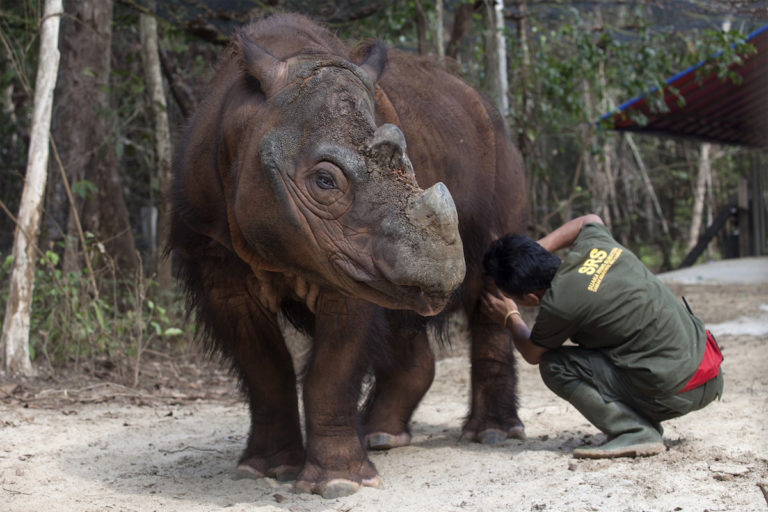
Within the rhinoceros family (rhinocerotidae), the Sumatran rhino is the most ancient species, having emerged more than 20 millions years ago.
It is not part of the same genius (the level above the species in taxonomy) than African rhinos (White and Black rhinos belong to the Dicerotini genius) which are about 5 millions years younger. Indian and Javan rhino (that belong to the Rhinocerotini genius) are more recent than the others.
The Sumatran rhino is the last representative of an otherwise extinct family of rhino, that included the wolly rhino hunted to extinction by humans 10’000 years ago.
It is the smallest of all known rhino species. It is 1 to 1,5 meter high, about 2 to 3 meters long and weights between 600 and 950 kg.
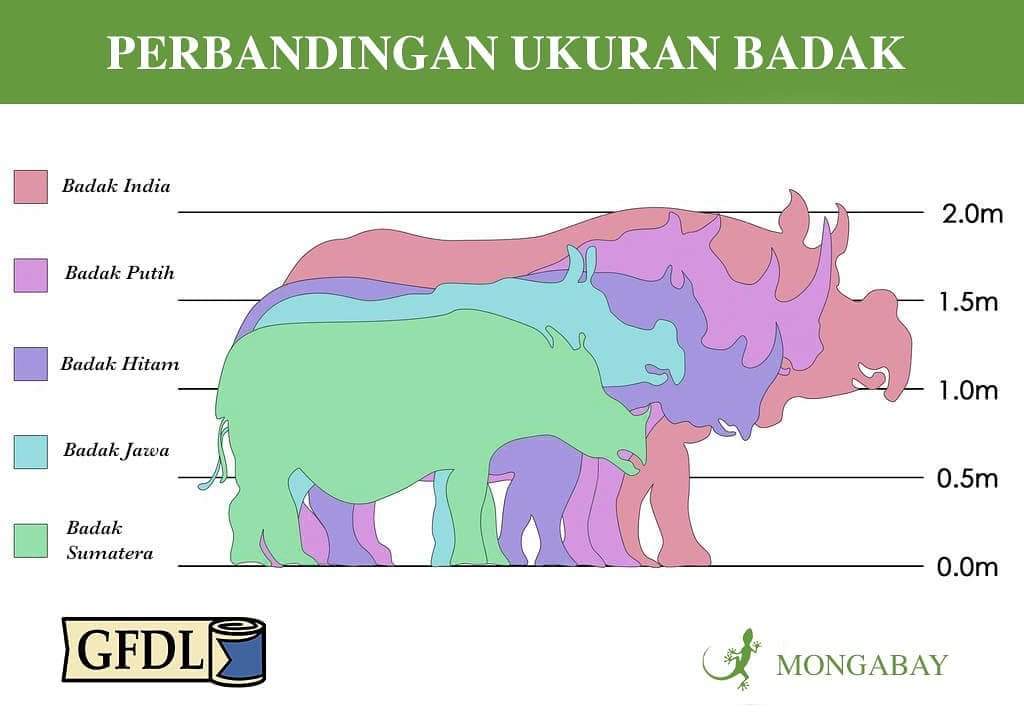
Sumatran rhinos are solitary animals. When brought together, experience in zoos and breeding facilities have shown that male and female frequently fight, resulting in injuries.
It is not a dwelling species. Female usually roams a 2’000 ha territory (3’000 ha for males).
Their lifespan in the wild is estimated to be around 35 to 40 years.
Sumatran rhinos are slow breeders : female are sexually mature at 4 and male at 7 years old. The reproductive functions of the females are quite particular : they can only ovulate if they are in contact with males. On top of that if female don’t get pregnant and breed, they developed uterus cancer and lose their ability to reproduce.
Gestation time is 15 to 16 months. Female can give birth to a calf about every 3 years.
Habitat
The original range of the Sumatran rhinos was all Southeast Asia but also parts of India and China, but the species had now gone extinct everywhere but in Indonesia.
The species has only goes extinct recently in Malaysia.
We have no certitude about the optimal habitat of the Sumatran rhino. Nowadays, the remaining rhinos are found in isolated hilly parts of rainforests. But it has been assumed that they were only pushed there by human expansion. It is possible that the best breeding and feeding ground for rhinos are actually dry lowland forests.
Sumatran rhinos are maybe the most endangered land mammal on Earth. They have become almost impossible to encounter in the wild, but through camera traps. Haerudin, a 62 years old program manager at the Indonesian Rhino Foundation, has told in an interview that he saw them only once in the wild despite 40 years spent studying the animal.
How many Sumatran rhinos live today ?
There are evidence that Sumatran rhinos still live in the wild in 4 different places in Indonesia. This is the last country in the world with a wild population.
- Way Kambas National Park (Sumatra)
- Bukit Barisan Selatan National Park (Sumatra)
- The Leuser Ecosystem (Sumatra)
- Kalimantan (Indonesian part of Borneo).
It is estimated that only 30 to 80 individuals still live in the wild.
On top of that there is as of November 2019 a population of 8 captive rhinos in Indonesia :
- 7 kept in the Sumatran Rhino Sanctuary (SRS) of Way Kambas (south of Sumatra). This population is made of 3 males and 4 females. 2 out of the 7 rhinos were born there (a male and a female).
- A lone and rather old female rhino captured in East Kalimantan in 2019, kept in the SRS of Kerian Lestari (East Kalimantan).
The captive population of Sumatran rhino in Tabin Wildlife Reserve in Sabah, Malaysia, has gone extinct in November 2019 with the death of the last female Iman. It followed the death of the last male Tam in May 2019.
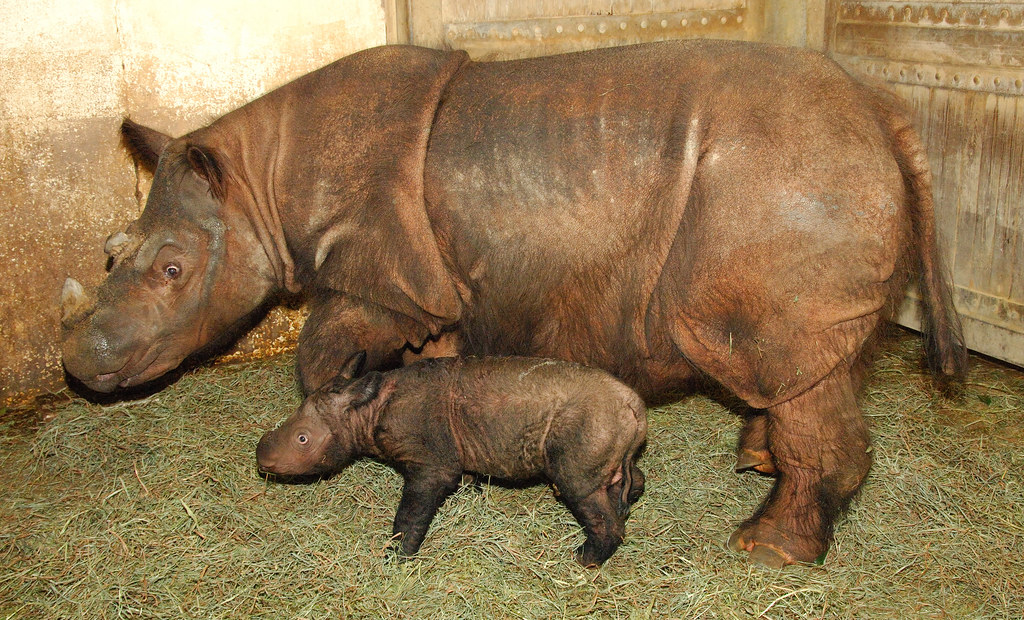
Estimating the population
In 1986, the Sumatran rhino was listed as an endangered species by the International Union for the Conservation of Nature (IUCN) with an estimated population of 400 to 800 individuals. Ten years later, the species became listed as critically endangered and the population estimated then at 400 rhinos. In 2008, the estimate was down to less than 300.
According to John Payne, director of the Borneo Rhino Alliance (BORA, mostly active in Malaysia), estimates since the 1970s were mostly made up based on limited field observations and lots of assumption. A small area was surveyed, and based on evidence collected, a minimum number of rhino presence was established. Then the number was extrapolated to unsurveyed areas and inflated based on assumptions of missed rhinos during the survey.
But according to Payne, rhinos are easy to spot : they leave dungs and footprints. His point is that such assumptions are misleading and that scientists have overestimated Sumatran rhinos population for decades.
This argument is backed by historical evidence. For instance in 1990, experts estimated that the population of Sumatran rhinos was around 500 individuals in Kerinci Seblat National Park. Yet in 2004, experts concluded that rhinos had actually gone extinct in the area. Poaching was a reality, but it is very likely that the original estimation was way too high.
Reasons behind the population decline
As for the rest of the Indonesian wildlife, the Sumatran rhino is affected by the shrinkage and fragmentation of its natural forest habitat.
The Sumatran rhinos also suffered from poaching, whether they are catched in snares intended for other species or specifically hunted for their horn that has a high value in Chinese medicine.
The biological nature of the Sumatran rhino makes it especially at risk in increasingly fragmented forests : isolated females simply loose the capacity to breed. And even when they can, the population needs time to recover given the reproductive cycle of females.
A studies published in Current Biology in 2018 has cast a new light on the fate of the Sumatran rhino. Based on DNA analysis, researchers estimated that the population of rhino might have plummeted to 700 individuals as early as 12’000 years ago !
Review of remaining habitats of the Sumatran rhino
The Leuser ecosystem
- Location : Aceh and North Sumatra provinces (north of Sumatra)
- Status : encompasses the Gunung Leuser National Park (about 1’000’000 ha)
- Size : about 2’000’000 ha
- Official population estimate : up to 50
- Breeding : Yes
The Leuser ecosystem is a large zone of high biodiversity interest, that encompasses the Gunung Leuser National Park. It is a rocky and mountainous environment, making population surveys especially difficult there.
A significant population of more than 20 rhinos and showing signs of breeding is reported in the western part of the area. At least 12 rhinos have been identified by cameras trap in a specific valley.
There would be in total 6 clusters of rhinos but only 2 have a population larger than 2 individuals.
Poaching is also stronger here than anywhere else, due to the difficulty to enforce the law is such a large and difficult area.
26 teams are mobilized on a monthly basis in Aceh to monitor the population.
Way Kambas National Park
- Location : Lampung province (south of Sumatra)
- Status : National Park
- Size : 126’000 hectares
- Official population estimate : up to 30.
- Breeding : Yes
This national park is not very large and patrolled by dedicated Rhino Protection Units (RPU), deployed by the Indonesian Rhino Foundation (YABI) since 1998. There is a functioning network of camera traps operating.
The Indonesian Rhino Foundation (YABI) has also taken recent pictures of rhino calves. But camera traps also records a decreasing number of rhinos.
Patrols are also finding poached elephants in the parks, and the horn of rhino is worth more than elephant ivory on the black market…
A conservative estimates for the park population would be 12 to 15 individuals, with some breeding females.
The park is located next to the Sumatran Rhino Sanctuary of Way Kambas.
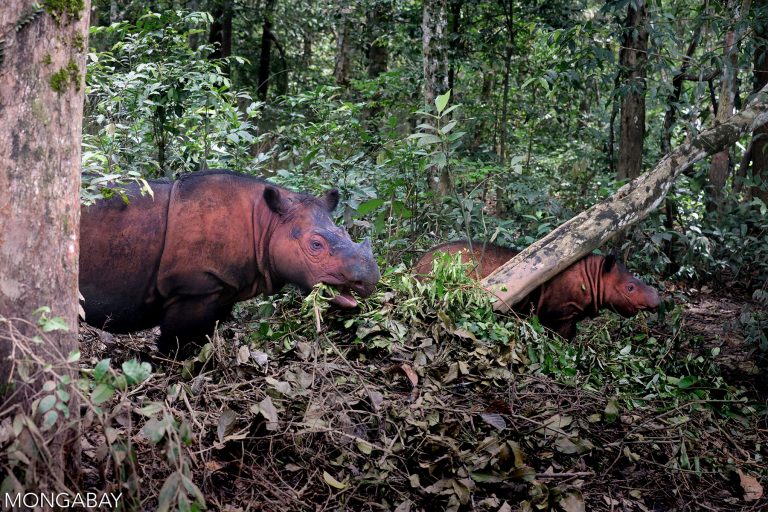
Bukit Barisan Selatan National Park
- Location : Lampung province (south of Sumatra)
- Status : National Park
- Size : 374’000 hectares
- Official population estimate : 17-24
- Breeding : Unsure
This national park is also patrolled by Rhino Protection Units (RPU) and Wildlife Conservation Society’s Smart Patrols.
No rhino has been caught on camera traps since 2014, raising serious doubts about the actual size of the population here.
Evidence collected (dungs, footprint, wallows and twisten branches from eating leaves) by the RPUs have also been partially contested (Mongabay).
It is very likely that only a handful of rhino remain in this habitat, and definetly not enough to constitue a viable population.
However a recent studies by the Wildlife Conservation Society and Panthera found that the Sumatra tiger population was on the rise in Bukit Barisan Selatan NP. This gives hopes for the remaining rhino of Bukit Barisan Selatan.
Kalimantan
- Location : scattered in East Kalimantan
- Status : no population known within established national parks
- Size : n.a
- Official population estimate : a handful
- Breeding : Unsure
Some rhinos are still living in Kalimantan’s forests (Indonesian part of Borneo island).
In 2013, WWF anounced they had found a remnant population of about 15 rhinos in Kalimantan. Yet experts have seen only evidence for 3 individuals, including a female and a calf caught on camera.
Nevertheless 2 wild rhinos were captured using pit traps in 2016 and 2019.
Does the Sumatran rhino have a future ?
Based on various sources (IUCN, Payne and Pusparini, see references at the end), I understand that a Sumatran rhino population is viable from 20 rhinos (both male and females). The Indonesian authorities see the treshold slightly lower at 15 individuals.
So today, there is only one population that is likely to be viable on the long term : the western Leuser population in Aceh.
In May 2017, scientists attending the International Workshop on Capture and Translocation of Indonesia Sumatran Rhinos reached a consensus and forwarded their recommendation to the Indonesian government. They advocate the rapid capture of all rhinos from Bukit Barisan Selatan and Kalimantan as well as fertile rhinos from Way Kambas (the national park part, not the SRS).
The message from the experts is clear : without a captive breeding program, the Sumatran rhino is doomed.
Saving the Sumatran rhinos from extinction through captive inbreeding is not hopeless. For instance, the European bison had been hunted to extinction in the 1920s, it was latter reintroduced in the wild from captive individuals. From 12 founding animals, the population is now higher than 7’000 individuals.
The Indonesian’s government policy on Sumatran rhino
The government has vowed his support to capture isolated rhino as soon as possible.
In March 2016 conservation organization and the Indonesian government managed to capture a female rhino, named Najaq, using a pit trap in East Kalimantan. But the animal died during its translocation, due to previous wounds caused by a poacher’s snare, as well as error made during the operation. The rhino was notably left 54 hours in her pit trap, probably causing her stress and overheating (rhino spent most of their times in wallows).
The Sumatran Rhino Rescue partnership was established in September 2018 to coordinate capture efforts along NGOs.
In November 2018, a adult female Sumatran rhino, named Pahu, fell into a pit trap in West Kutai regency in East Kalimantan. Within 24 hours the rhino was moved to Kelian Lestari SRS nearby. But Pahu is quite old (about 25 years old), and is half as big as a normal rhino. It’s possible that it suffers from dwarfism.
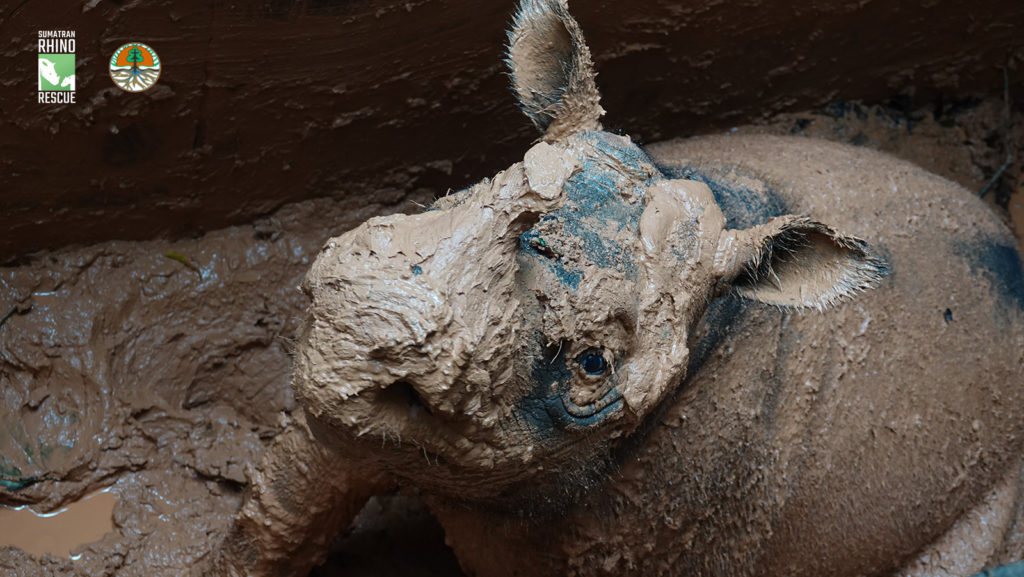
Several experts (such as veterinary authority Nan Schaffer or John Payen from the Borneo Rhino Alliance) have lamented the low ambition of the Indonesian arguing that there was no time left anymore to save the species.
One of the main reason behind the failure of the first 84-95 breeding program was that too many captured female rhinos were isolated in the wild and unable to reproduce due to physiological reasons exposed previously (females develop uterus cancer if they don’t breed, which they cannot do if there are isolated far from males).
The Ministry of Environment and Forestry seems reluctant to launch ambitious capture program in Bukit Barisan Selatan and Way Kambas National Park. In early 2019, new population monitoring exercises were conducted in Way Kambas. The official target is to finalize the rhino counts within 3 years… It has nonetheless vowed to capture and relocate all non viable rhino populations.
Update December 19 : Indonesian officials announced their intention to capture 3 wild rhinos from Way Kambas National Park in 2020 (Mongabay).
As of 2019, a second SRS has been built in Lerian Lestari in West Kutai regency (Kalimantan). A third SRS is to be opened in Aceh by 2021, with a plan to capture 5 rhinos from the wild in Leuser. This is in line with the recommendation of the 2017 WWF report. In the meantime the SRS of Way Kambas is to be expanded.
In November 2019, the Ministry announced that they will attempt an IVF using Pahu’s eggs and Andalas’ sperm (Mongabay).
Can captive breeding save the sumatran rhino ?
Breeding Sumatran rhino in captivity has been an ongoing effort since now close to 35 years. We have 2 main issues here :
- Actually breed the rhinos
- Ensure a minimum of genetic diversity
Breaking the rhino code
In 1984, several international zoos, conservationists and government officials launched an ambitious captive breeding program for the Sumatran rhinos.
From 1984 to 1995, 40 wild rhinos were captured in Malaysia and Indonesia and send to local zoos as well as others in the UK and the US.
By 1995, half of them had died and none of them successfully bred in captivity. For many years, the program was considered an utter failure.
If found the following explanation in a 2017 WWF report : “the most significant reasons included insufficient knowledge of key elements of rhino breeding biology, poor husbandry, unwillingness to share rhinos, more than half of the rhinos unable to breed due to age-related problems or reproductive patholoy and no work done to apply advanced technology“.
Basically not one knew a thing about the Sumatran rhinos. Zoos fed them like African rhinos they were experienced with, but it turns out that Sumatran rhinos fall ill if they don’t eat leaves from branches. Also it took years of patient work to understand that female cannot ovulate if they are not in contact with a male (Sumatran rhinos are usually isolated because they tend to fight each others otherwise).
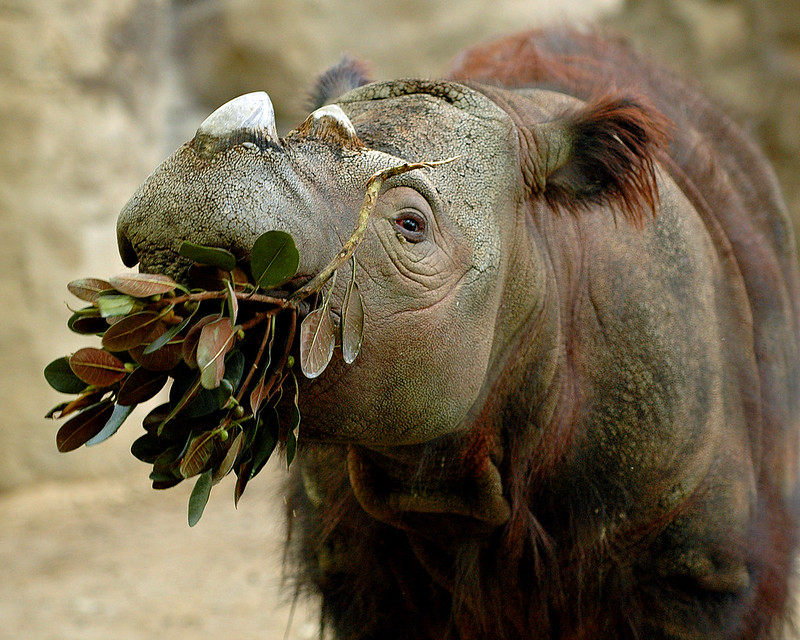
Many key discoveries can be attributed to the caretakers of the Cincinnati zoo in the US. By 1995, only 3 Sumatran rhinos remained in the US, 1 male and 2 females. Only one female was capable of giving birth. The 3 rhinos were gathered in Cincinnati in August.
In 2001, after more than a decade of work (and 5 lost pregnancies) they made a breakthrough : the birth of male Andalas, the first Sumatran rhino born in captivity in more than a century.
Then in 2004 and 2007, 2 other calves were born from the same original mother. In 2007, Andalas and his brother Harapan were sent over from the US to their homeland of Indonesia in the SRS of Way Kambas.
The SRS of Way Kambas, founded in 1996 got his first successful breeding only in 2005, from Ratu, a female among the 6 wild rhinos captured between 1995 and 2016.
Preserving genetic diversity
Inbreeding is a huge issue for rhino conservation. Today out of the 7 rhinos kept in SRS Way Kambas, the 3 males are all related (a father, his brother and his son). And only one female is able to reproduce naturally, while her daughter is not yet fertile.
So there is an urgent need to introduce male rhinos from other bloodlines in Way Kambas.
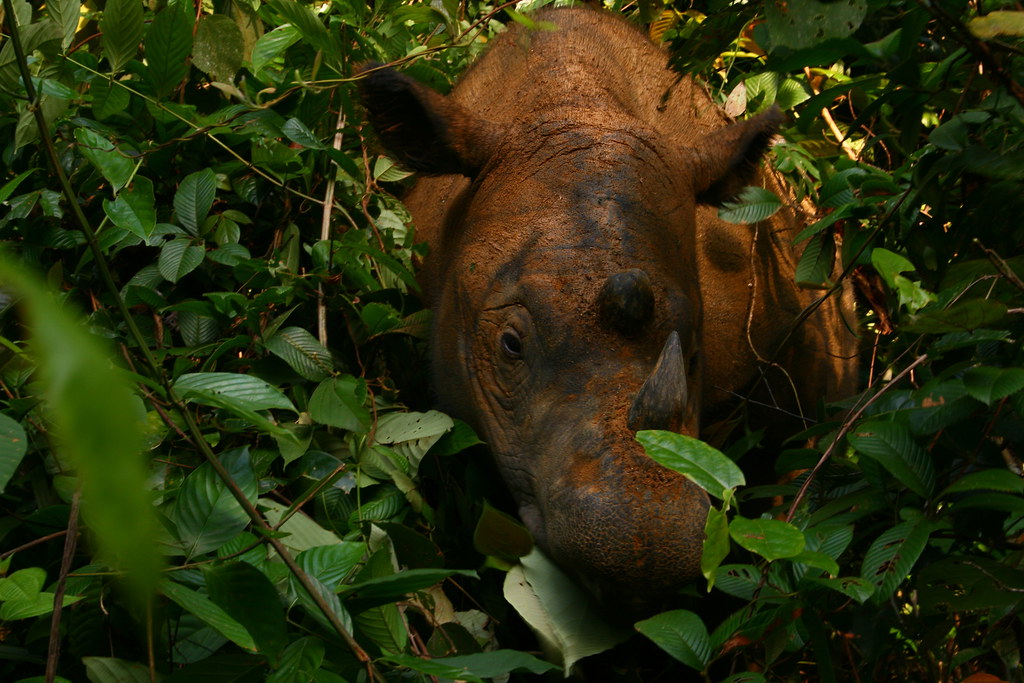
Until recently, Malaysia had still 3 rhinos in captivity, but one female and one male were not fertile. The remaining female Iman, was believed to be fertile but was unable to carry a calf after uturus problems.
From 2012, conservationists have called for an exchange of Indonesian sperm against Malaysian ovocites but the governments never reached an agreement amidst political and administrative disputes.
Sperm vials obtained from the male rhinos Andalas in the SRS Way Kambas have been sitting iddle in a freezer since 2015. We are now in late 2019, all the rhinos of Malaysia have died and the vials are still in a freezer…
Malaysia had tried 6 times to perform an IVF on Iman’s eggs with low-quality sperm from ageing Iman (who died in May 2019). All attempts failed to produce an embryo. Indonesia has always refused to send available sperm from healthy males. It is not clear if other eggs have been preserved in Malaysia.
Series – Conservation Status
Source
- Pusparini & al, 2015, Rhinos in the Parks: An Island-Wide Survey of the Last Wild Population of the Sumatran Rhinoceros, PLoS ONE 10(9) (link).
- J.Payne & K.Yoganand, 2017, “Critically Endangered Sumatran Rhinoceros. Inputs for Recovery Strategy and Emergency Actions 2017-2027”, WWF Report (link).
- J.Hance’s outstanding series “The Rhino Debacle” for Mongabay, telling the failure of the first Sumatran rhino breeding program in the 80s and the 90s (Mongabay, Part 1, Part 2, Part 3, Part 4).
- J.Hance, “Worst-case scenario: There could be only 30 wild Sumatran rhino left”, Mongabay, 7/11/17 (link). Great articles about the current evidence behind population assessments.
- Mays & al, 2018, Genomic Analysis of Demographic History and Ecological Niche Modeling in the Endangered Sumatran Rhinoceros Dicerorhinus sumatrensis, Current Biology 28, 70-76.
- The website of the Indonesian Rhino Foundation (Yayasan Badak Indonesia), mostly in Indonesian.
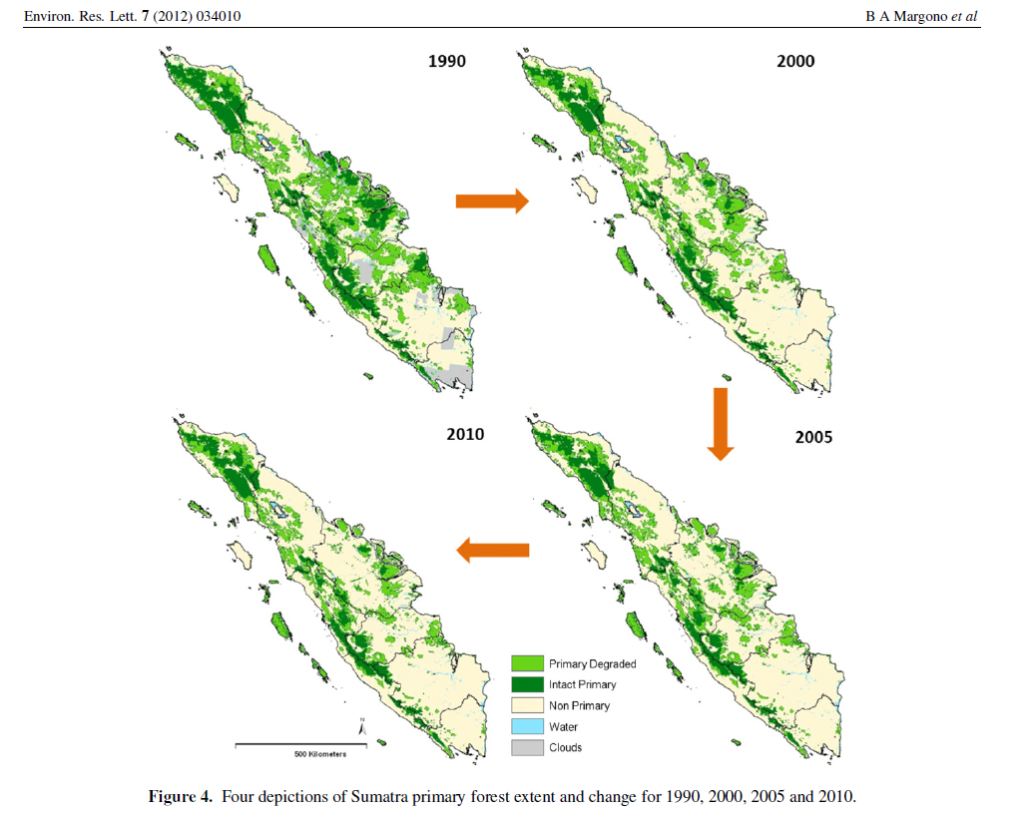
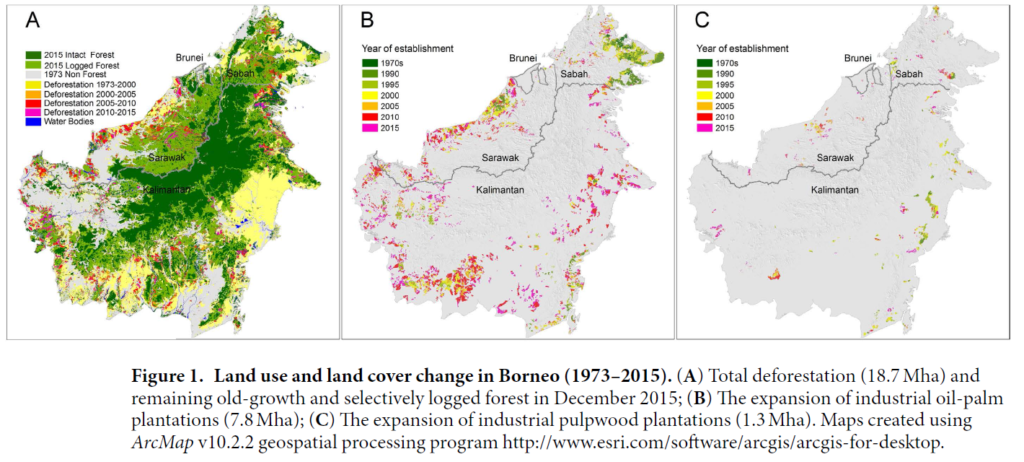
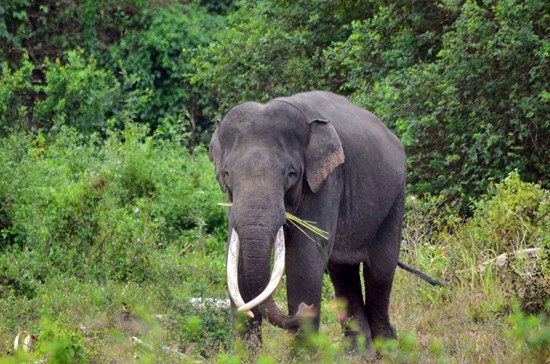
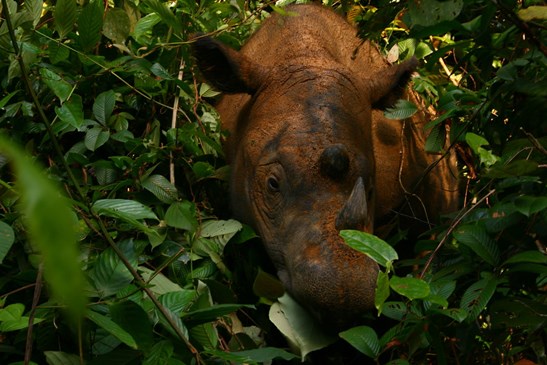
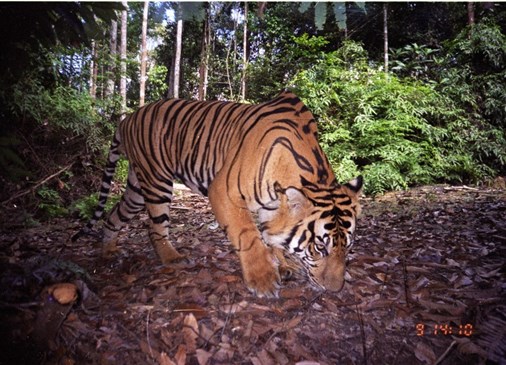
Leave a Reply